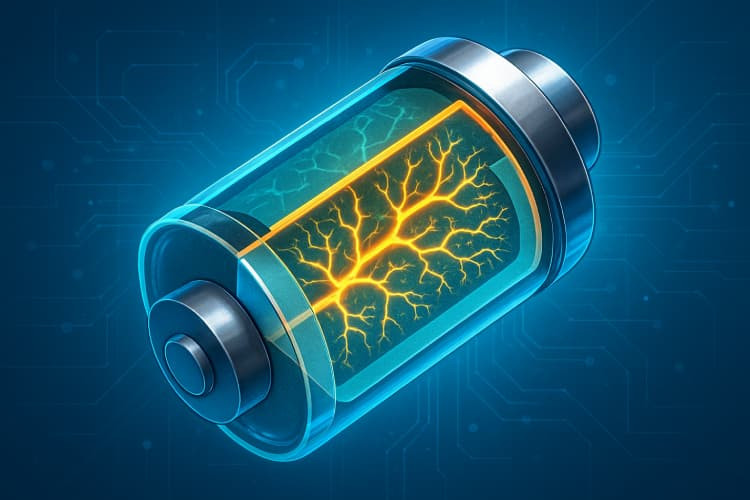Radiation-Hardened Capacitors for Extreme Environments
Technical Analysis | 16-07-2025 | By Liam Critchley

Key Things to Know:
- Dielectric capacitors are critical for advanced electronics but require radiation resistance for extreme environments.
- Researchers developed a dendritic nanocomposite film capacitor that combines high energy density with strong radiation tolerance.
- The prototype capacitor achieved 217.8 J/cm³ energy density, 20 Mrad radiation resistance, and stability from −100 °C to 170 °C.
- This innovation opens doors for capacitor use in aerospace, nuclear energy, and medical radiation systems.
Dielectric capacitors have become critical components in advanced electronic systems because they have both a high-power density and an ultrafast charge-discharge mechanism. However, as advanced electronic devices start to become integrated into more extreme environments, they also need to be shielded from them.
Dielectric capacitors are already widely used in pulsed power electronic devices, hybrid electric vehicles (HEVs), smart grids, and microwave communication technologies, but are also becoming ever more prevalent in aerospace, nuclear energy and medical radiation therapies. All these new potential applications can subject energy storage devices to high amounts of radiation, and the technologies that are available today with high energy storage performance tend to lack robust radiation resistance that is practical in these applications over long time periods.
Researchers have now taken a new approach to developing and fabricating suitable capacitors by moving away from more conventional materials and using dendritic nanocomposites to achieve a balance of energy storage performance and radiation resistance for these environmentally demanding applications.
Emerging Technology Applications Require Radiation-Resistant Energy Storage Devices
The growing need for advanced technologies in extreme environments has involved aerospace technology, nuclear energy reactors, particle accelerators, nuclear imaging methods and radiotherapy treatments, all of which expose the electronics to some dose of radiation that can affect their normal operation.
Therefore, these applications require more radiation-resistant dielectric capacitors. Low levels of ion, electron, ultraviolet (UV) and gamma radiation have been shown to have a positive effect on dielectric capacitors by reducing leakage currents and modifying the defects in the materials. However, dielectric capacitors that have been exposed to high radiation doses have been shown to have a higher number of defects, structural degradation, and higher leakage currents. Therefore, there is a need to better understand how radiation affects capacitors (positively and negatively), especially for gamma radiation, which is the most common radiation source in extreme environments.
Ferroelectric oxide materials have emerged recently as a potential material for energy storage devices used in high radiation environments due to having a high radiation resistance and a high polarisation. In other devices, such as random access memory (RAM) and piezoelectric sensors, these materials have shown radiation resistance up to 10 Mrad. However, when it comes to energy storage, efforts have so far been limited due to a high remnant polarisation and a low breakdown field strength that has limited their energy storage capacity.
Dendritic Nanocomposites Emerge as a Potential Option
Nanocomposite materials with a dendritic structure have emerged as a potential option for dielectric capacitors. While a dendritic structure often has negative connotations for energy storage devices, in this instance, the branching patterns (not actual harmful dendrites found in lithium batteries) and interface regions of the nanocomposites improve the conductivity and mechanical stability of ferroelectric oxide materials. For this reason, the researchers chose to incorporate dendrite-like structures in a ferroelectric nanocomposite to improve the chance of creating a radiation-resistant and high dielectric energy performance capacitor.
The researchers first used simulation software to look at how self-assembled nanocomposite films with dendritic-like structured ferroelectric regions (embedded within an insulator) can be designed to overcome the typical challenges and trade-offs that exist within dielectric capacitors. Introducing dendrite-like structures to the nanocomposite was found to improve the energy storage performance through the formation of nano-polar regions that prevent electric breakdown processes. The simulations showed that these regions used a combination of the intrinsic radiation-resistant properties of ferroelectric materials and the large surface area of the interfaces located along the dendritic structures to facilitate a self-healing effect that improves the radiation resistance.
The self-healing mechanism was found to be driven by interactions between insulating phases and the ferroelectric regions at the interface. These interfaces were found to be defect sinks that could remove any radiation-induced defects in the material, such as interstitial atoms and oxygen vacancies, to improve radiation resistance in the capacitor so that any degradation in performance would be minimised under high radiation doses.
Upon discovering the mechanistic side of how these dendritic nanocomposites can improve the radiation resistance of dielectric capacitors, the researchers put it into action using a physical prototype. The researchers fabricated a high-performance film capacitor by introducing a dendritic-like nano-polar (DNP) microstructure into self-assembled nanocomposite films composed of a lead zirconate titanate (PZT) ferroelectric material with dielectric materials, such as magnesium oxide.
PZT was chosen as the ferroelectric material due to its versatile phase structure, which allowed for more design flexibility when optimising the radiation resistance against the energy storage properties of the device. On the other hand, magnesium oxide was chosen as the dielectric material because it has a wide bandgap that improves the breakdown strength compared to other insulator materials. The choice of the two materials enabled the construction of multiple phase boundaries and domain walls within the nanocomposite film that were exploited to improve both the radiation resistance and energy storage properties of the capacitor.
The nanocomposite capacitor developed by the researchers had a high energy density of 217.8 J cm-3, an efficiency of 78%, excellent reliability over 1000 cycles, a high temperature stability that allowed it to operate in a temperature range of −100 °C to 170 °C, and a very high radiation resistance of 20 Mrad. The combination of radiation tolerance, thermal stability and long-term reliability, coupled with the energy properties, makes the capacitors feasible for satellite and spacecraft power systems, portable medical pulsed power systems, and harsh-environment industrial electronics.
The work in this study goes a long way to developing dielectric capacitors that have beneficial energy and radiation resistance properties. The work done to date could also help to bring in a new way of designing capacitors for radiation-exposed power systems, including not just PZT-based capacitors, but also barium and hafnium-based ferroelectric oxide dielectric capacitors as well.
Reference:
Nan C-W. et al, Radiation-hardened dendritic-like nanocomposite films with ultrahigh capacitive energy density, Nature Communications¸16, (2025), 3882.

